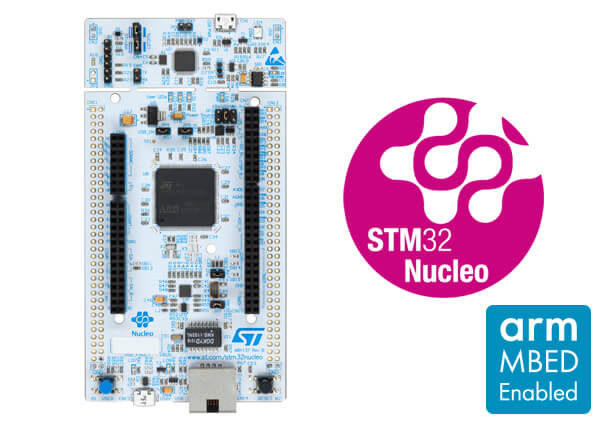ST Nucleo F767ZI¶
Overview¶
The STM32 Nucleo-144 F767ZI boards offer combinations of performance and power that provide an affordable and flexible way for users to build prototypes and try out new concepts. For compatible boards, the SMPS significantly reduces power consumption in Run mode.
The Arduino-compatible ST Zio connector expands functionality of the Nucleo open development platform, with a wide choice of specialized Arduino* Uno V3 shields.
The STM32 Nucleo-144 board does not require any separate probe as it integrates the ST-LINK/V2-1 debugger/programmer.
The STM32 Nucleo-144 board comes with the STM32 comprehensive free software libraries and examples available with the STM32Cube MCU Package.
Key Features
STM32 microcontroller in LQFP144 package
Ethernet compliant with IEEE-802.3-2002 (depending on STM32 support)
USB OTG or full-speed device (depending on STM32 support)
3 user LEDs
2 user and reset push-buttons
32.768 kHz crystal oscillator
Board connectors:
USB with Micro-AB
SWD
Ethernet RJ45 (depending on STM32 support)
ST Zio connector including Arduino* Uno V3
ST morpho
Flexible power-supply options: ST-LINK USB VBUS or external sources.
On-board ST-LINK/V2-1 debugger/programmer with USB re-enumeration
capability: mass storage, virtual COM port and debug port.
Comprehensive free software libraries and examples available with the STM32Cube MCU package.
Arm* Mbed Enabled* compliant (only for some Nucleo part numbers)

More information about the board can be found at the Nucleo F767ZI website.
Hardware¶
Nucleo F767ZI provides the following hardware components:
STM32F767ZI in LQFP144 package
ARM 32-bit Cortex-M7 CPU with FPU
Chrom-ART Accelerator
ART Accelerator
216 MHz max CPU frequency
VDD from 1.7 V to 3.6 V
2 MB Flash
512 KB SRAM
16-bit timers(10)
32-bit timers(2)
SPI(6)
I2C(4)
I2S (3)
USART(4)
UART(4)
USB OTG Full Speed and High Speed(1)
USB OTG Full Speed(1)
CAN(2)
SAI(2)
SPDIF_Rx(4)
HDMI_CEC(1)
Dual Mode Quad SPI(1)
Camera Interface
GPIO(up to 168) with external interrupt capability
12-bit ADC(3) with 24 channels / 2.4 MSPS
12-bit DAC with 2 channels(2)
True Random Number Generator (RNG)
16-channel DMA
LCD-TFT Controller with XGA resolution
Supported Features¶
The Zephyr nucleo_f767zi board configuration supports the following hardware features:
Interface |
Controller |
Driver/Component |
|---|---|---|
NVIC |
on-chip |
nested vector interrupt controller |
UART |
on-chip |
serial port |
PINMUX |
on-chip |
pinmux |
GPIO |
on-chip |
gpio |
ETHERNET |
on-chip |
ethernet (*) |
USB |
on-chip |
usb_device |
COUNTER |
on-chip |
rtc |
I2C |
on-chip |
i2c |
PWM |
on-chip |
pwm |
SPI |
on-chip |
spi |
WATCHDOG |
on-chip |
independent watchdog |
ADC |
on-chip |
ADC Controller |
RNG |
on-chip |
True Random number generator |
DAC |
on-chip |
DAC Controller |
- (*) nucleo_f767zi with soc cut-A (Device marking A) has some ethernet
instability (https://github.com/zephyrproject-rtos/zephyr/issues/26519). Use of cut-Z is advised. see restrictions errata: https://www.st.com/content/ccc/resource/technical/document/errata_sheet/group0/23/a6/11/0b/30/24/46/a5/DM00257543/files/DM00257543.pdf/jcr:content/translations/en.DM00257543.pdf
Other hardware features are not yet supported on this Zephyr port.
The default configuration can be found in the defconfig file:
boards/arm/nucleo_f767zi/nucleo_f767zi_defconfig
For mode details please refer to STM32 Nucleo-144 board User Manual.
Default Zephyr Peripheral Mapping:¶
The Nucleo F767ZI board features a ST Zio connector (extended Arduino Uno V3) and a ST morpho connector. Board is configured as follows:
UART_2 TX/RX/RTS/CTS : PD5/PD6/PD4/PD3
UART_3 TX/RX : PD8/PD9 (ST-Link Virtual Port Com)
UART_6 TX/RX : PG14/PG9 (Arduino UART)
USER_PB : PC13
LD1 : PB0
LD2 : PB7
LD3 : PB14
ETH : PA1, PA2, PA7, PB13, PC1, PC4, PC5, PG11, PG13
USB DM : PA11
USB DP : PA12
I2C : PB8, PB9
PWM : PE13
SPI : PD14, PA5, PA6, PA7
Note
The Arduino Uno v3 specified SPI device conflicts with the on-board ETH device on pin PA7.
System Clock¶
Nucleo F767ZI System Clock could be driven by an internal or external oscillator, as well as the main PLL clock. By default, the System clock is driven by the PLL clock at 72MHz, driven by an 8MHz high-speed external clock.
Serial Port¶
Nucleo F767ZI board has 4 UARTs and 4 USARTs. The Zephyr console output is assigned to UART3. Default settings are 115200 8N1.
Programming and Debugging¶
Applications for the nucleo_f767zi board configuration can be built and
flashed in the usual way (see Building an Application and
Run an Application for more details).
Flashing¶
Nucleo F767ZI board includes an ST-LINK/V2-1 embedded debug tool interface.
Flashing an application to Nucleo F767ZI¶
Here is an example for the Hello World application.
Run a serial host program to connect with your Nucleo board.
$ minicom -b 115200 -D /dev/ttyACM0
Build and flash the application:
# From the root of the zephyr repository
west build -b nucleo_f767zi samples/hello_world
west flash
You should see the following message on the console:
$ Hello World! nucleo_f767zi
Debugging¶
You can debug an application in the usual way. Here is an example for the Hello World application.
# From the root of the zephyr repository
west build -b nucleo_f767zi samples/hello_world
west debug